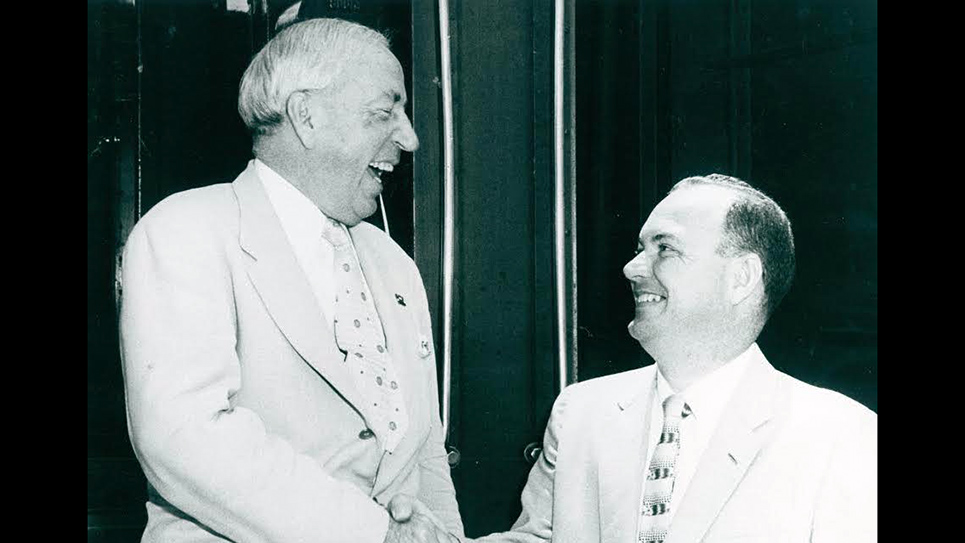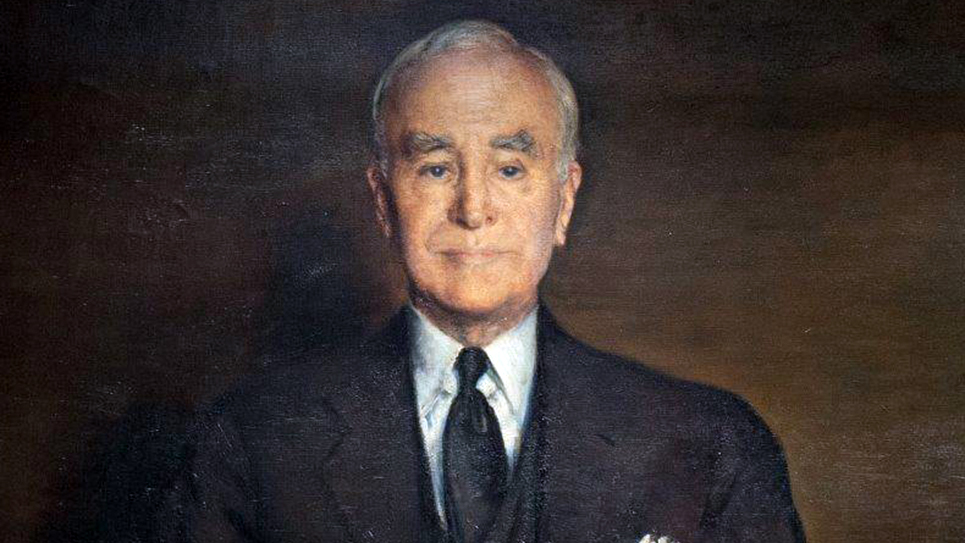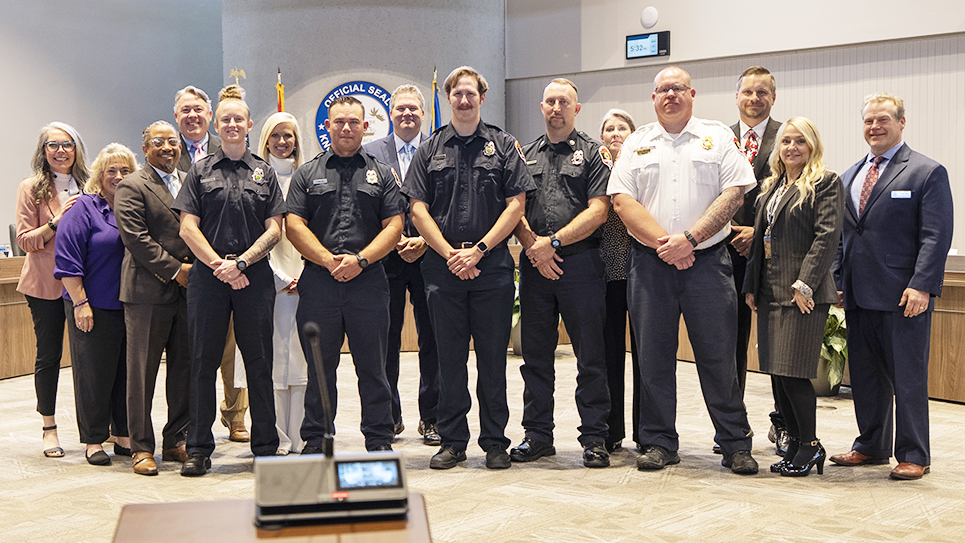Carroll Reece and Jimmy Quillen
From 1921 until 1997, two men occupied the seat in the U.S. House of Representatives from Tennessee’s First District, with the exception of six years. Carroll Reece served 36 years, as did Jimmy Quillen; however, Reece’s service, unlike Quillen’s, was not continuous. Reece was upset in the 1930 election by Oscar Byrd Lovette, who ran as an independent in a remarkable 14-day campaign. The issue was Reece’s having supported President Herbert Hoover’s position on private versus public power. East Tennesseans were most decidedly in favor of private power and cheaper rates even before the advent of the Tennessee Valley Authority. It was the only election inside the First District that Carroll Reece ever lost and although he served but a single term in the U.S. House of Representatives, O. B. Lovette remains the only man ever to beat Reece at the ballot box. Reece came back to beat Lovette twice in the 1932 election, first winning the Republican primary and then fending off another challenge by Lovette as an Independent in the general election.
Reece served another 14 years before voluntarily giving up his seat in Congress after having been elected as chairman of the Republican National Committee in 1946. Ousted as chair in 1948, Reece ran the first serious race by a GOP candidate for the United States Senate since 1916 and lost to Estes Kefauver. Tennessee was still a solidly Democratic state and in 1950 Reece once again launched a campaign to take back his seat in the House of Representatives from his successor in Congress, Dayton Phillips. It was a hard-fought and exceptionally bitter campaign, especially on the part of Congressman Phillips. Reece won the Republican primary and must have experienced a feeling of déjà vu as Phillips promptly ran in the general election as an Independent. Reece won again, but Phillips outran the Democratic nominee in the fall election. Reece reestablished himself as the real political power inside the First District and presided over a growing Republican Party in Tennessee. Reece lived to see Dwight Eisenhower carry the state twice, winning in 1952 and 1956, as well as Richard Nixon winning Tennessee in 1960. Carroll Reece was reelected every two years, but he died five months after having been reelected in 1960 from lung cancer.
Both Reece and Quillen built formidable political organizations loyal to themselves and the Republican Party inside the First Congressional District. Both were millionaires. Reece had married Louise Goff, the only child of the immensely wealthy Guy Goff, who had been a United States senator from West Virginia. An economist by education and training, Reece proved to be a shrewd businessman and owned four banks inside the First Congressional District, as well as tobacco warehouses and, at one time, bought the Bristol Herald Courier.
Carroll Reece had first gone to Congress in 1920 and quickly observed the constituent service operation of Kenneth D. McKellar, who remains to this day the Tennessean who has served longer in Congress than any other representative or U.S. senator from the Volunteer State. Reece picked up the same habit of promptly responding to every telephone call and letter and went to great lengths to be helpful to voters. When Reece first went to the House, there were no pensions for those who had served in the American armed services. Pensions had to be passed for ex-servicemen or their widows and orphans by congressmen and senators as special acts of Congress. A highly decorated hero from the First World War, Reece was always highly sensitive to the needs of fellow veterans. At one time, Reece was said to have sponsored more private bills for pensions for ex-servicemen and their families than any other single member of Congress.
Neither Reece nor Quillen were orators, nor did either man sponsor or pass many bills (aside from Reece’s penchant for private bills for specific constituents), but they concentrated upon service to the people who elected them. Like his predecessor, once elected to Congress, Jimmy Quillen entrenched himself by doing all he could to be helpful to the people of his district. No problem was too big or too small to merit his personal attention. Reece was one of the first congressmen to realize the importance of hospitality to those home folks visiting Washington, D.C. Serving during the decade of the 1950s and the country being more prosperous, it became a more common practice for graduating high school seniors and other classes to visit the nation’s Capitol. The teachers, parents and students found a most accommodating congressman in Carroll Reece, whose staff was ready, willing and able to help facilitate and assist them in every way possible. Reece had a favorite spot on the lawn of the Capitol where he liked having a picture taken with visiting classes. The Reece staff would send a copy not only to every person appearing in the photograph but also to the hometown newspapers, who proudly printed it in the next edition. The amiable congressman, with a ready grin and firm handshake, was remembered for decades to come, and those youngsters voted for Reece just as their grandparents and parents had before them.
That same hospitality became routine amongst the best offices on Capitol Hill. Almost invariably the congressmen and senators whose staffs made a practice of becoming experts in extending services and courtesies to constituents seemed to be unbeatable at the ballot box. Once elected to the House of Representatives, Jimmy Quillen followed the same practices as Reece.
Both Carroll Reece and Jimmy Quillen valued the friendships and relationships they made along the way. One of the most striking things to me in writing a biography of Carroll Reece was the large number of young men named for him inside the First Congressional District. I didn’t realize until he passed that my friend Carroll Reagan’s full name was Carroll Reece Reagan. The veteran congressman lived long enough to see the wedding announcements of numerous namesakes engaged to their future brides.
Jimmy Quillen had owned two local newspapers before joining the Navy in the Second World War. After returning home to Tennessee, he married Cecile Cox and started a real estate development and insurance business, which quickly prospered. Quillen was a friend and supporter of Congressman Reece and managed his campaigns in Sullivan County, which had a strong Democratic base in elections. In 1954, Jimmy Quillen became a candidate for the Tennessee House of Representatives, facing a Democratic incumbent in the general election. Reece campaigned alongside of Quillen in Sullivan and Hawkins counties, lending his own support to his young friend’s candidacy. Quillen won the election by 96 votes. Two years later, Quillen won by more than 7,000 votes. Almost immediately, Quillen expressed his interest in running for Congress should Reece opt to retire.
One of the oddest aspects of the news media covering Carroll Reece, at least to me, is the constant speculation throughout his long political career that he might retire. That rumor seemed to circulate just about every year, although there wasn’t the slightest evidence the congressman intended to quit. Quite the opposite, in fact. Carroll Reece died at 71, but there is no doubt in my mind that had he been alive and healthy enough, he would have been running again had he been 81.
Jimmy Quillen acknowledged he might be interested in running for the U.S. House of Representatives in 1956 should Reece choose to retire and if the congressman would fully endorse his candidacy. Carroll Reece continued with his usual hectic schedule of traveling throughout the First District, which had been his habit throughout his time in Congress. Carroll Reece was omnipresent inside his own district, popping up at family reunions, veterans’ events, service club luncheons, party rallies and picnics. Jimmy Quillen did the same thing when he served in the House.
Reece showed no inclination to retire and was overwhelmingly reelected in 1956. After the New Year, Quillen sent up yet another trial balloon, saying he “will run” for Congress in the event Reece didn’t seek reelection in 1958. Quillen was careful to add he would not officially announce his candidacy until the congressman “says what he is going to do.” The state legislator was equally cautious in stressing the point he would never think of challenging Reece.
Carroll Reece was going to be 70 years old when his term expired and there were rumors Louise Reece didn’t want her husband to run again.
It was certainly true Jimmy Quillen had demonstrated he was a potent vote-getter, having won by a large majority and even outran President Eisenhower in his legislative district. Although Reece did his best to appear to be reluctant to run again, the congressman filed for reelection in 1958. Reece said his inclination to retire from the House had been overridden by his concern for the country in troubled times. Quillen had to content himself with running for reelection to the Tennessee General Assembly. The country was in the midst of a serious recession, which profoundly affected Republican fortunes in the 1958 elections. Still, Reece and Quillen both won easily. Even in Knox County, the election had gone to the Democrats where 13 Democrats were elected to the quarterly court, the forerunner of the county commission; only six Republicans had been elected.
Carroll Reece still showed no inclination to retire and was reelected yet again in 1960, beating Arthur Bright, who was a perennial contender for Congress. A superintendent at Eastman Kodak for 38 years, Bright had run for the U.S. House of Representatives every two years since 1948. For 20 years, Arthur Bright tried to win election to Congress as a Democrat from Tennessee’s First Congressional District. Bright had run behind Reece and Congressman Dayton Phillips in the 1950 general election, winning less than 16% of the votes cast. Two years later, Bright lost the Democratic primary. In 1954 Bright tried again and won the primary but lost the general election to Carroll Reece. Arthur Bright showed that name recognition was important when he beat a sitting judge for the Democratic nomination in 1956, yet lost the general election to Congressman Reece again, winning only 27% of the vote. In the Democratic year of 1958, Bright lost the primary to Mayne Miller. Bright faced Reece for the last time in 1960 and won just under 28%.
When the First Congressional District seat became open in 1962, Bright tried for the Democratic nomination yet again, but lost by a wide margin to businessman Herbert Silvers, who in turn, lost the general election to Jimmy Quillen. Bright ran in the general election as an Independent but was swamped. Bright won the Democratic nomination to run against Congressman Quillen in 1964 and, even in that banner year for Democrats, lost badly. For some reason, Arthur Bright didn’t run for Congress in 1966 but made his last campaign in 1968 when he won the nomination but polled less than 15% of the vote. That election pretty much was the end of Bright’s attempt to win a seat in the House of Representatives. Arthur W. Bright died in 1981.
Reece appeared to be tan and healthy when he was feted by friends and supporters in December of 1960, where 130 people gathered at a banquet for the congressman. Reece looked fine in a photograph taken at a birthday party for Vice President Richard Nixon in January of 1961. Nixon had just lost a close presidential election to John F. Kennedy in November.
Later that month, Reece began having serious respiratory problems. In the beginning, it was believed Reece was suffering the effects of having been gassed during the First World War. Congressman Reece checked himself into Bethesda Naval Hospital where he was diagnosed with advanced lung cancer. Carroll Reece died on March 19, 1961.
Jimmy Quillen had to wait until 1962 to run for Congress as Reece’s widow, Louise, was elected in the 1961 special election to succeed her husband. Quillen defeated a host of other Republicans, including former Congressman Dayton Phillips, to represent the First District. Quillen remained there until his own retirement in 1997. © RAY HILL







